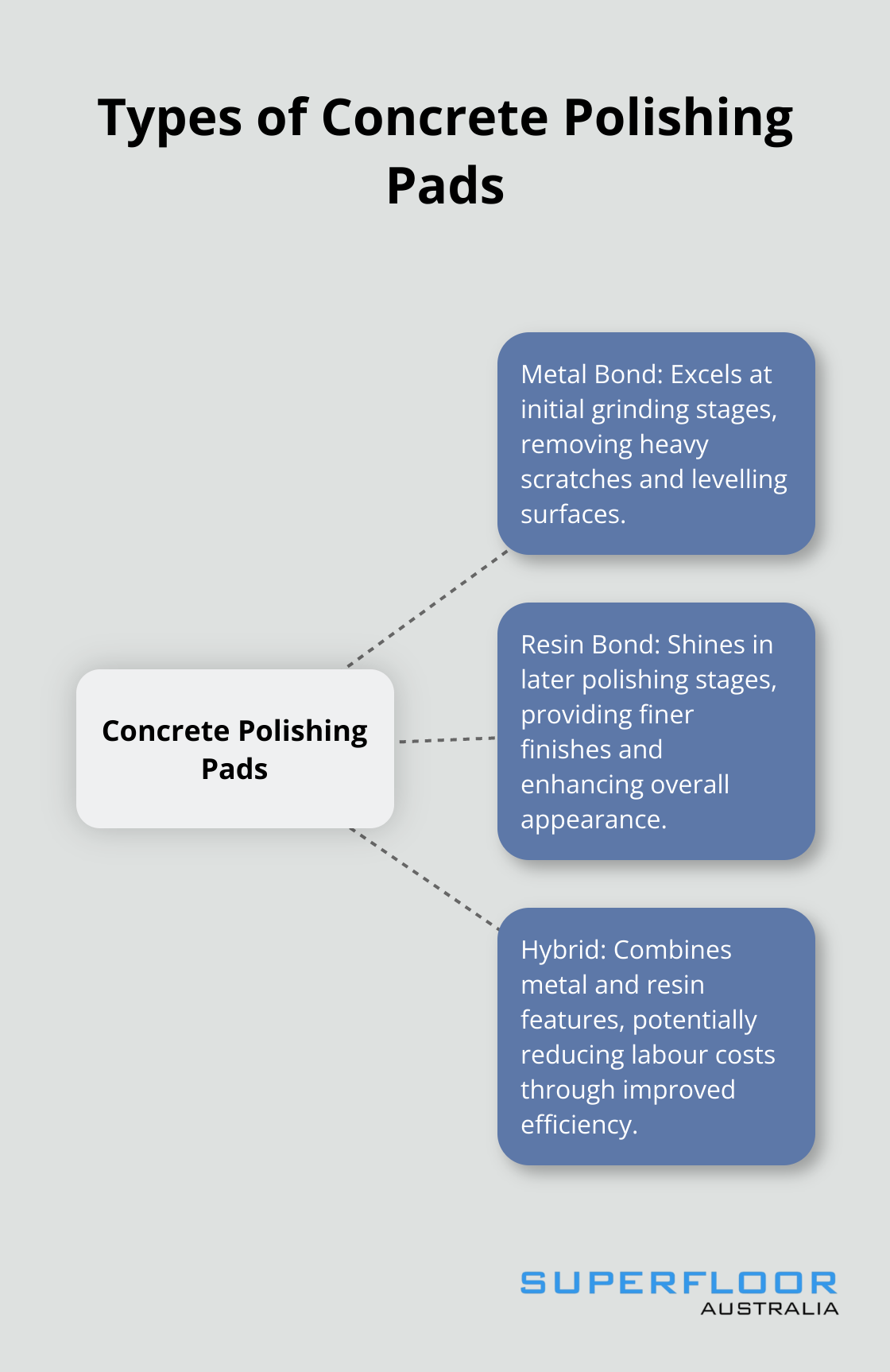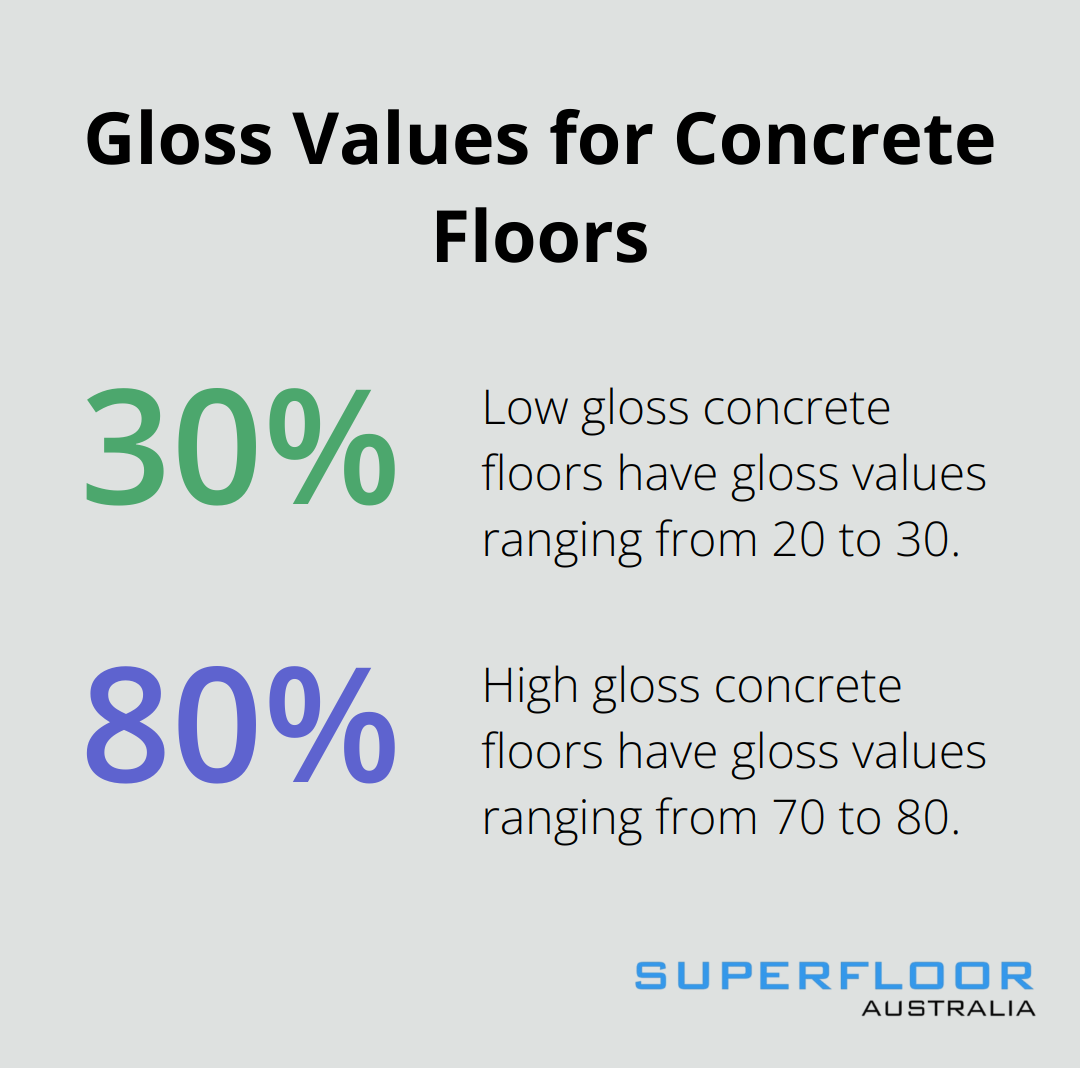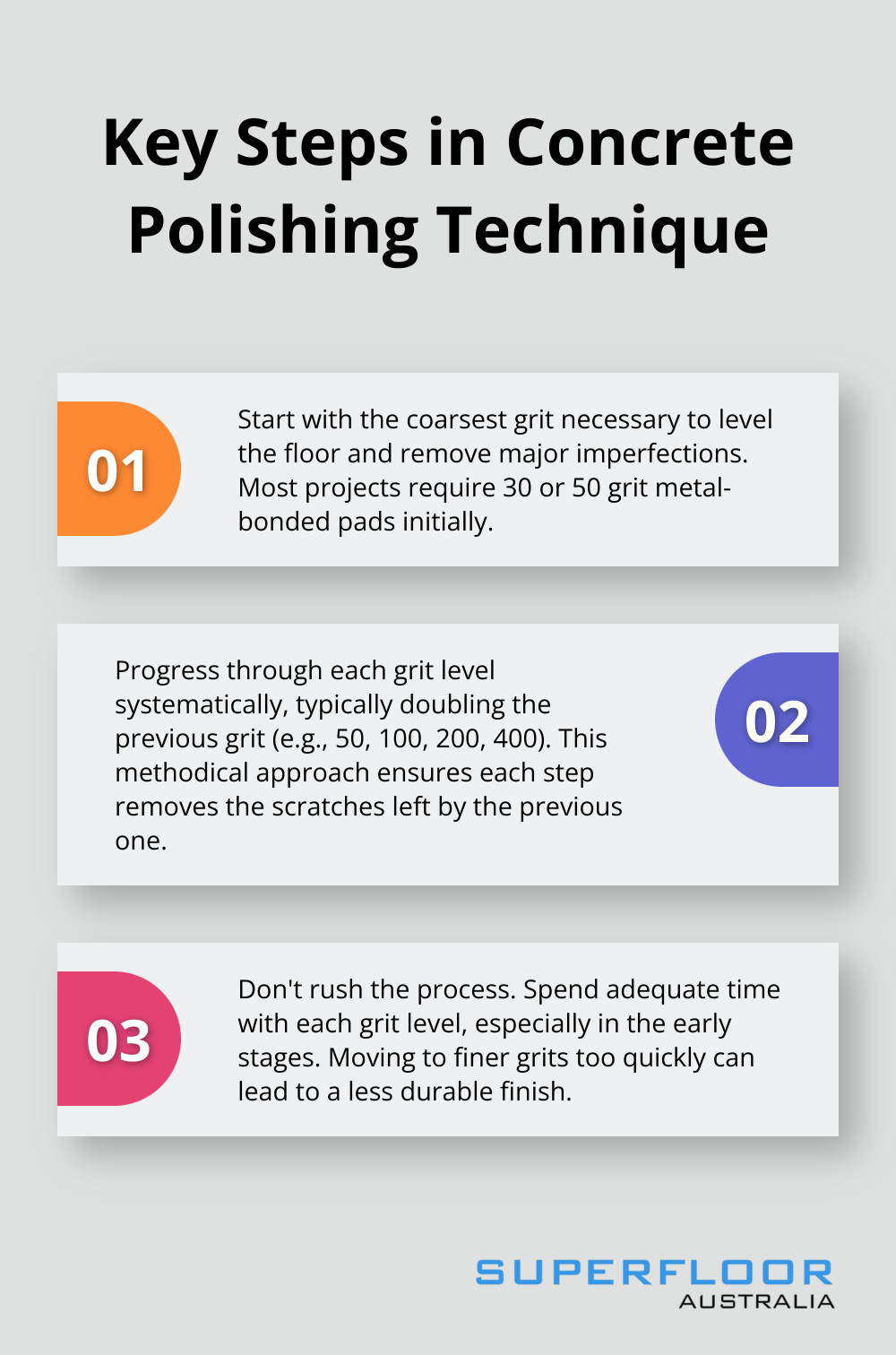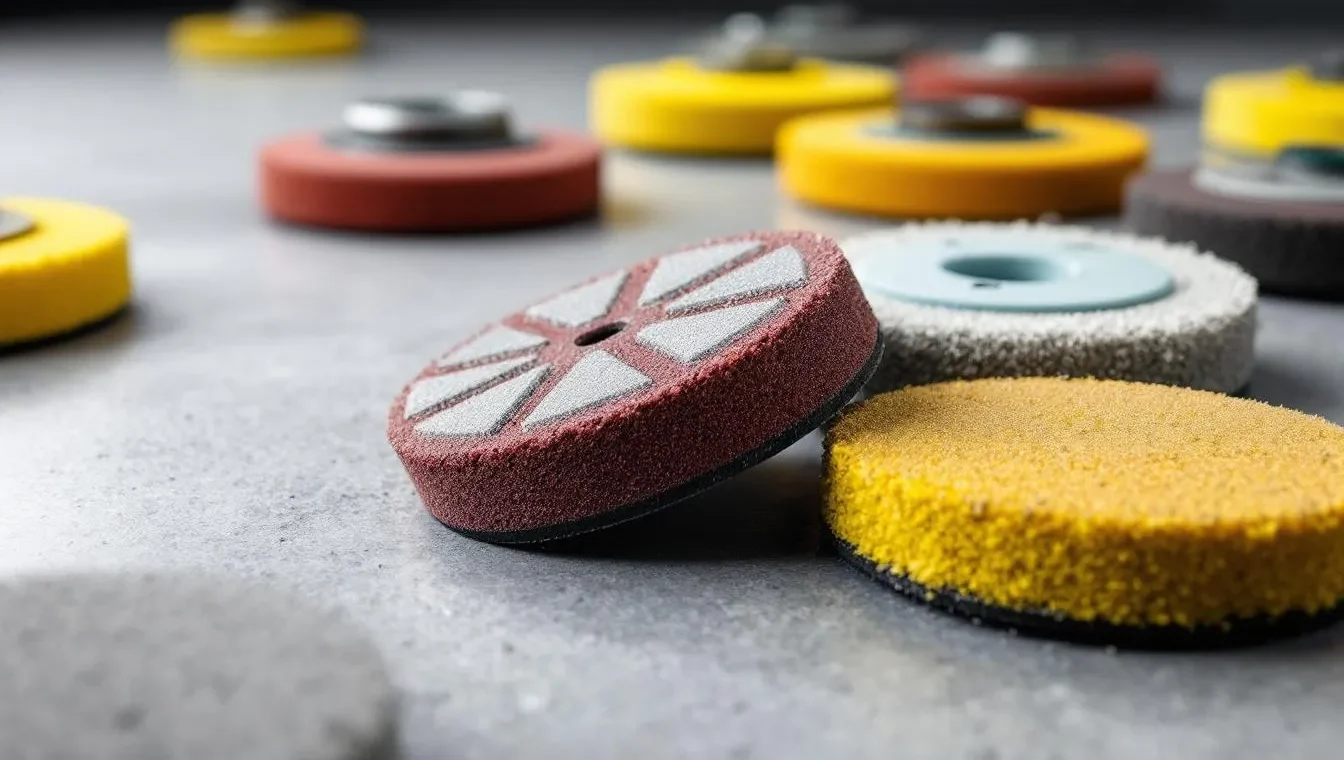Concrete polishing pads are essential tools for achieving a flawless finish on concrete surfaces. At Superfloor Australia, we understand the importance of selecting the right pads for your project.
This guide will help you navigate the world of polishing pads, from understanding different types and materials to choosing the best options for your specific needs. We’ll also share best practices to ensure your concrete polishing project is a success.
What Are Concrete Polishing Pads?
Types of Polishing Pads
Concrete polishing pads transform dull, rough concrete into smooth, glossy floors. Three main types exist: metal bond, resin bond, and hybrid. Metal bond pads excel at initial grinding stages, removing heavy scratches and levelling surfaces. Resin bond pads shine in later polishing stages, providing finer finishes and enhancing overall appearance. Hybrid pads combine metal and resin features, potentially reducing labour costs through improved efficiency.

Material Composition
The material composition of polishing pads significantly affects their performance. Diamond serves as the primary abrasive in high-quality pads due to its hardness and durability. The Concrete Polishing Association of America notes that silicon carbide tends to wear quicker than aluminium oxide, but it is also sharper and more friable, making it still a long-lasting option.
Resin-bonded pads work well for wet polishing applications, while ceramic-bonded pads suit dry polishing better as they withstand higher temperatures without smearing. The quality of diamonds used in the pads plays a vital role; higher-grade diamonds lead to better performance and longevity, while lower-grade diamonds result in quicker wear and poorer surface quality.
Grit Levels and Their Functions
Polishing pad grit levels range from coarse (30/50 grit) for heavy grinding to ultra-fine (8500/BUFF) for high-gloss finishes. The American Concrete Institute recommends a progressive approach, starting with coarser grits and moving to finer ones. A typical sequence would include using 80 and 150 grit metal-matrix segments followed by application of the hardening silicate, then polishing using 100 or higher grits.
Initial grinding typically uses 30-50 grit pads to remove major imperfections. Medium grits (100-400) handle honing, while fine grits (800-1500) polish the surface. Ultra-fine grits (3000+) achieve mirror-like finishes.
Skipping grits or jumping to a higher grit too soon can leave uneven textures or make it harder to achieve a quality finish. A systematic progression through grit levels ensures a flawless, professional-grade result for every project.
Pad Size and Shape
The size and shape of polishing pads also impact their effectiveness. Larger pads (7 inches) work best on flat surfaces but struggle in narrow sections or edges. Smaller pads (3-4 inches) excel in processing edges and tighter spaces. A 4-5 inch pad often strikes a balance, offering versatility for various tasks.
The cutting surface pattern of the pad affects its lifespan and cutting efficiency. Pads with a coarse, open pattern (30 and 50 grit) suit aggressive stock removal due to effective residue ejection. Narrow channel pads (for polishing, 400 to 3000 grit) may clog when used for aggressive cutting applications.
As we move forward to discuss factors for choosing polishing pads, it’s important to consider how these various pad characteristics interact with different concrete surfaces and project requirements.
Selecting the Right Polishing Pads for Your Project
Assessing Your Concrete Surface
The condition of your concrete surface impacts pad selection. Older, rougher surfaces require more aggressive metal-bonded pads to level the floor and remove major imperfections. Newer or smoother surfaces allow you to start with less aggressive resin-bonded pads.
Concrete hardness also influences pad choice. Softer concrete needs softer-bonded pads to prevent gouging, while harder concrete demands more aggressive pads for effective material removal. A simple scratch test can gauge your concrete’s hardness: if a copper coin easily scratches the surface, you’re dealing with softer concrete.
Determining Your Desired Finish
Your end goal dictates the progression of pads you’ll use. A high-gloss finish requires a complete set of grits (potentially up to 3000 or higher). A satin finish might only need progression to 800 grit.
Gloss values express the degree of reflection when light hits the concrete floor surface, and range from 20 to 30 (low gloss) to 70 to 80 (high gloss).

The Concrete Polishing Association of America recommends a minimum of five grinding steps for a high-gloss finish. Each step removes the scratches left by the previous one, gradually refining the surface. Skipping steps might save time initially but often results in subpar results and more work later.
Considering Project Scope and Timeline
Large commercial projects often benefit from more durable, longer-lasting pads to minimise downtime and pad changes. For a 10,000 square foot warehouse floor, high-quality diamond pads could potentially save on labour costs compared to lower-quality alternatives.
Smaller residential projects (e.g., a 500 square foot home) might allow for more flexibility in pad choice, but quality should never be compromised. Using professional-grade pads can reduce polishing time by several hours.
Time constraints can influence pad selection too. If you work under a tight deadline, hybrid pads that combine the aggressive cutting of metal bonds with the fine polishing of resin bonds can speed up the process. These pads can potentially reduce the number of steps needed, saving valuable time without sacrificing quality.
Balancing Budget and Quality
While budget constraints are a reality, it’s important to prioritise quality when selecting polishing pads. Cheaper pads might seem attractive initially, but they often wear out faster and produce inferior results. This can lead to increased labour costs and potential rework.
High-quality pads (such as those with premium diamond grits) might cost more upfront but offer better performance and longevity. They can cover larger areas before needing replacement, potentially saving money in the long run.
Try to strike a balance between your budget and the quality required for your specific project. Consider factors like the expected foot traffic, maintenance requirements, and the lifespan of the polished surface when making your decision.
The next section will explore best practices for using these carefully selected pads to achieve optimal results in your concrete polishing project.
Mastering Concrete Polishing Techniques
Perfect the Polishing Progression
Start with the coarsest grit necessary to level the floor and remove major imperfections. Most projects require 30 or 50 grit metal-bonded pads initially. Progress through each grit level systematically, typically doubling the previous grit (e.g., 50, 100, 200, 400). This methodical approach ensures each step removes the scratches left by the previous one.
Don’t rush the process. Spend adequate time with each grit level, especially in the early stages. Moving to finer grits too quickly can lead to a less durable finish. The Concrete Polishing Association has created terminology to define the products and processes used in concrete polishing.

Manage Water for Optimal Results
Water plays a key role in concrete polishing. For wet polishing, maintain a consistent flow of water to keep the pads and concrete surface cool. This prevents overheating, which can damage both the pads and the floor. However, avoid flooding the surface, as excess water can dilute densifiers and other treatments (reducing their effectiveness).
In dry polishing, control dust effectively with a high-quality vacuum system. This improves visibility, protects your health, and keeps the work area clean. Some contractors prefer a combination approach, using wet methods for initial grinding and switching to dry for final polishing stages. Water protects users from toxic silicon particles, safeguarding their health.
Extend Pad Life Through Proper Care
Clean your pads after each use to remove concrete slurry and debris. For resin-bonded pads, a stiff brush and water usually suffice. Metal-bonded pads may require more vigorous cleaning with a wire brush to remove built-up material.
Store pads flat to prevent warping. Avoid stacking heavy items on top of them, which can cause deformation. Keep them in a cool, dry place away from direct sunlight to prevent degradation of the bonding material.
Rotate pads regularly during use to ensure even wear. A report from the Concrete Polishing Association indicates that a proper bond can enhance lifespan by 20%, reducing the frequency of replacements. When a pad starts to lose effectiveness, replace it promptly. Using worn pads can lead to inconsistent results and may damage the concrete surface.
Troubleshoot Common Issues
Troubleshooting is an essential skill in concrete polishing. If you notice swirl marks, it often indicates you’re moving too quickly or using too much pressure. Slow down and let the pad do the work. Uneven gloss levels might mean you’ve missed spots or haven’t spent enough time with each grit level. In this case, go back a step and repolish the entire area.
For stubborn stains or deep scratches, spot-treat problem areas with a lower grit before proceeding. This targeted approach can save time and ensure a uniform finish across the entire surface.
Final Thoughts
Selecting the right concrete polishing pads will lead to outstanding results in your flooring projects. High-quality pads often outperform cheaper alternatives, lasting longer and saving time and labour costs. Proper care and maintenance of your pads will extend their lifespan and ensure consistent results across your projects.
We at Superfloor Australia understand the impact that choosing the right pads can have on your project’s success. Our expertise in delivering high-quality polished concrete flooring in Brisbane comes from years of experience and a commitment to using top-notch materials and techniques. We apply these insights to create durable, beautiful concrete surfaces that stand the test of time.
For professional concrete polishing services in Brisbane, contact Superfloor Australia. Our team will help you achieve the smooth, glossy finish you desire (using the most appropriate concrete polishing pads for your specific project). We look forward to assisting you in transforming your concrete surfaces into stunning, long-lasting floors.
